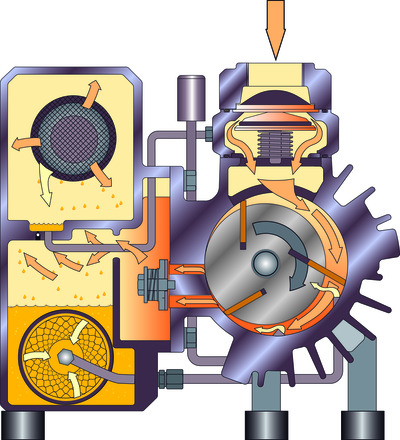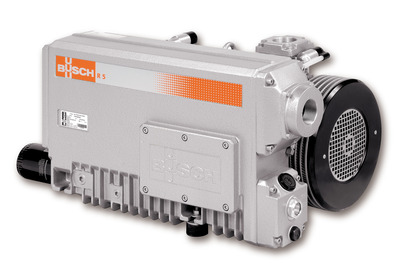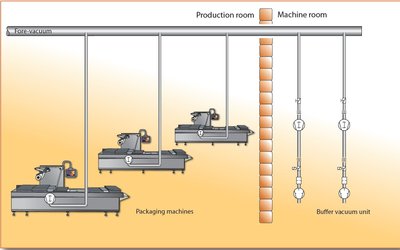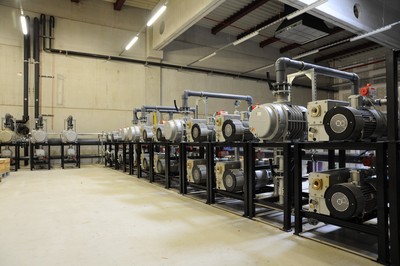Economical vacuum supply in meat-processing plants
Thursday, 06 February, 2014
An integrated packaging concept that guarantees finished products are packaged hygienically, reliably, swiftly and efficiently is an important component in modern production of meat and sausage products. This is why innovative meat-processing plants are continuously working to optimise their production processes and integrate their packaging lines into the overall process in the best possible manner.
The correct selection of vacuum generation systems can influence the operational reliability and cost-effectiveness of the packaging process. Various vacuum supply options are available, depending on the size of the plant and the production quantities involved. These alternatives are detailed and considered below to find the best possible solution with regards to technology and cost-effectiveness.
Vacuum packaging of meat and sausage products offers a fundamental advantage: the elimination of the air in the packaging drastically reduces the oxygen content, slows down the activity of bacteria requiring oxygen and thus significantly increases shelf life. Additionally, vacuum packaging is hygienic and enables the products to be presented in an attractive manner.

A wide range of vacuum packaging machinery is available on the market, meaning that there is a suitable packaging machine for all packaging requirements. Regardless of their design or size, these packaging machines have one thing in common: for all machines, negative pressure must be generated to achieve the necessary vacuum in the packaging. This can be achieved by either an integrated or a separate vacuum pump. Other alternatives include central vacuum supply systems to which several packaging machines are connected.
Integrated vacuum pump
Normally, the vacuum pump is integrated or set up separately in the immediate vicinity for all vacuum packaging machines - from the chamber machine to the thermoforming packaging machine. Oil-lubricated rotary vane vacuum pumps are almost exclusively used for this purpose (Figure 1). This type of vacuum pump, developed specifically for the packaging industry by Dr-Ing K Busch GmbH in the 1960s (Figure 2), has long been a standard in vacuum packaging.

The vacuum pump, either integrated or set up separately to the packaging machine, is the simplest and most common way of generating the vacuum for packaging. Short pipes between the vacuum chamber, sealing station and the vacuum pump guarantee that the air is rapidly sucked out of the packaging. Larger-scale thermoforming packaging machines with high packaging volumes may also be fitted with a roots vacuum pump. The combination of vane and roots vacuum pumps means the pump-down time is shorter. In practice, this means shorter cycle times and thus a larger quantity of packaged products per time unit. If several thermoforming machines are operated, at least partial centralisation of the vacuum supply should be considered.
Partial centralisation
With partial centralisation (Figure 3), the rotary vane vacuum pumps are removed from the actual packaging room and integrated into a central pre-vacuum system for all packaging machines in a separate room. Dry-sealed roots vacuum pumps are installed directly in the packaging machines and connected to the central pre-vacuum generation system with a pipe system. This design ensures that the roots vacuum pumps operate at maximum efficiency and thus enable short pump-down times during packaging.

Partial centralisation means the rotary vane vacuum pumps are eliminated from the production room, thus preventing the danger of aerosol emissions. With a partially centralised system, it is always logical to physically locate and operate from two to a maximum of five thermoforming packaging machines together. If more packaging machines are used, the investment costs are too high due to the roots vacuum pumps in the individual machines; thus, it is recommended to fully centralise the vacuum supply.
Central vacuum supply
Cost-effectiveness
Full centralisation of the vacuum supply (Figures 4 and 5) is generally an economically viable option from six packaging machines. Usually, it is safe to assume that substantially fewer vacuum pumps are required for a central vacuum supply than for a set-up of individual vacuum pumps directly beside the packaging lines. If the vacuum supply is subsequently converted from a decentralised to a centralised system, existing vacuum pumps can be integrated into the new centralised system, reducing the investment costs.

The substantially lower energy costs when using roots vacuum pumps should not be underestimated. The cooling requirement for the room climate is also reduced due to the fact that all vacuum pumps are located outside the packaging room. This, in turn, clearly improves the total energy consumption in favour of a centralised system.

Hygiene
The removal of all vacuum generators in the production and/or packaging room in turn eliminates the danger of food contamination through oil aerosols. Additionally, there is no need for employees to enter the hygienically sensitive packaging room for maintenance or repair work. Cleanroom conditions can therefore be created in the area surrounding the packaging lines.
Operation method
The individual packaging chambers are pumped out in two stages to be able to run maximum cycle frequencies on the packaging lines. To do so, the critical pressure gradient is utilised and thus achieves the fastest possible evacuation. This requires a low vacuum pump station for the initial evacuation and a fine vacuum pump station for the evacuation on packaging pressure. The reversing valves with the corresponding control units are attached to the packaging machines. They control the transition from a low to a fine vacuum.
The thermoforming vacuum pump station supplies the vacuum to the packaging machine moulding station. Here, the base film of the packaging is heated, sucked into the mould and shaped accordingly into packaging recesses.
This separation into various vacuum stations is necessary on the one hand, as the moulding and sealing functions run at different vacuums and, on the other, as a substantially lower pump suction capacity is required for the two-stage evacuation of the sealing chamber. The pipework serves as a vacuum buffer. This buffer is necessary to keep the packaging pressure at a constant level, even when all the packaging machines are running with the same number of cycles.
The central vacuum system is fully automatic: it activates individual vacuum modules if a greater vacuum is required and/or switches off individual vacuum modules if a smaller vacuum is required. If a vacuum pump fails in the low, fine or thermoforming pump stations, then the reserve pump is automatically activated. This ensures maximum operational safety for the vacuum supply to the packaging machines.
Maintenance
A central vacuum supply system has a modular design, meaning that individual modules can be disengaged for maintenance. When this happens, a reserve unit automatically activates. This means that maintenance work can be carried out during operation without affecting the production output of the packaging machines. In the central system, the individual rotary vane vacuum pumps are subjected to substantially lower loads relative to the individual units, thus extending the maintenance intervals. Installing the central system outside the production area also benefits maintenance, as maintenance work does not result in interruptions to operational processes or hygiene breaches.
Integration into the process control system
Central vacuum supply systems are very well suited for integration into the operational process control system (Figure 6), meaning that the vacuum plant can be controlled and monitored from a PC. Any arising indicators highlighting imminent faults can be easily identified and rectified before the machines fail. The necessary technical parameters can be permanently called up and the pressures in the vacuum lines are displayed in graph form. This allows all process-related data to be evaluated and archived. Valuable information is supplied to the quality assurance and repair departments.

Summary
In systems using two or more vacuum packaging machines, the operator or responsible head of operations should consider how the vacuum is generated. They should not forget that production (eg, with sausage fillers or tumblers) also requires vacuums that can likewise be supplied from a central vacuum supply. The different vacuums and suction capacities at the various vacuum applications make it necessary for a vacuum specialist to precisely analyse the actual situation and then offer tailored solutions.
Heat exchanger solutions for 5 challenging foodstuffs
In this article, five of the most challenging foodstuffs in terms of thermal processing are...
Optical tech sorts out the frozen veggies at Twin City Foods
The US frozen vegetable processor has partnered with Key Technology to install two optical...
Integrated technology for wastewater solution at beverage company
Rockwell Automation has provided integrated technology for PFi's wastewater treatment...














